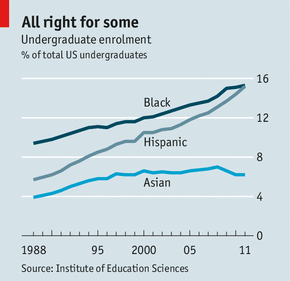Anna Bamford
The inconvenience of being mixed-race didn't hit me until my senior year of high school, when all of a sudden it felt like I was constantly being asked to designate my race or ethnicity on forms for standardized tests, financial support, and of course college applications. I remember encountering a college application that didn't allow me to describe myself as mixed race on their select-one-of-the-options-below online form, turning a no-brainer question into a matter of strategy: Should I choose Asian, to appeal to the university's desire for a diverse student body, or White, for the same reason? I don't remember what I chose, but even with my very limited understanding of how race impacted college admission, I had heard rumors of Asian-American students not getting in to universities because the number of qualified applicants would have made the school seem to lack diversity.
I found it very interesting that "Asian Americans and Affirmative Action" paralleled college admissions with restrictions on immigration, and I felt the article used compelling imagery to support this idea. I would have liked to see more discussion of the impact of college admission processes on post-graduation society, an idea only touched on in the end of the article's conclusion.
The graph below depicts how recent college admission processes have had mixed results for different racial groups, tying to Allred's argument that Asian Americans often don't fit into the US's black/white racial system: a boon for one racial group is not necessarily going to have the same effect for another, as a policy intended to benefit minorities proved not to provide the same results for Asian Americans as for Black, Hispanic, or even White students.

Unequal protection. (2013, April 27). [Graph]. Retrieved from https://www.economist.com/briefing/2013/04/27/unequal-protection
Allred, N.C. (2007, January). Asian Americans and Affirmative Action: From Yellow Peril to Model Minority and Back Again. Asian American Law Journal, Volume 14, Pages 57-84.
No comments:
Post a Comment